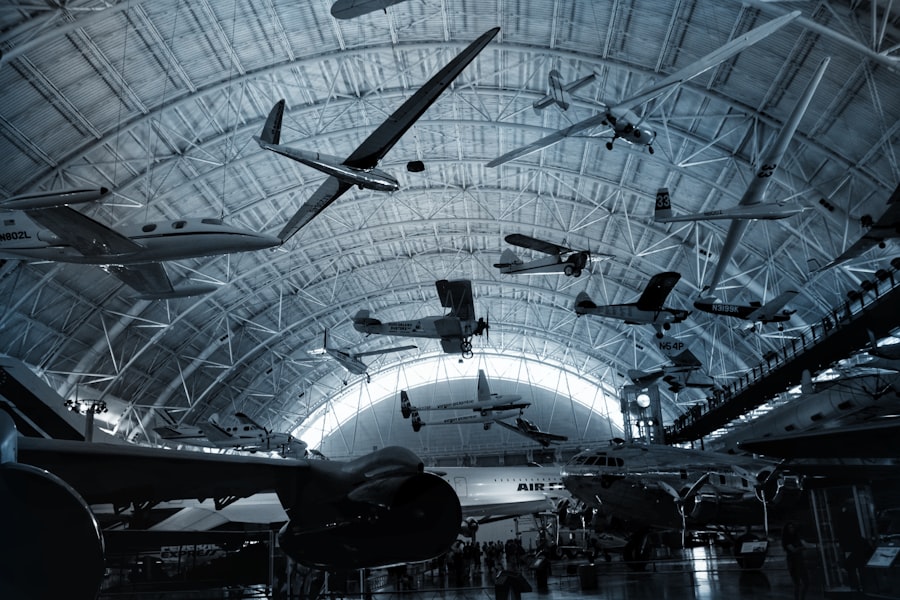The aerospace engineering market is a dynamic and multifaceted sector that encompasses the design, development, and production of aircraft, spacecraft, and related systems and equipment. This field is not only pivotal for commercial aviation but also plays a crucial role in defense, space exploration, and satellite technology. The aerospace industry has evolved significantly over the decades, driven by technological advancements, regulatory changes, and shifting consumer demands.
As a result, aerospace engineering has become a cornerstone of modern transportation and communication systems, influencing global economies and international relations. Aerospace engineering is divided into two primary branches: aeronautical engineering, which focuses on vehicles that operate within the Earth’s atmosphere, and astronautical engineering, which deals with vehicles designed for travel beyond the atmosphere. This dual focus allows for a wide range of applications, from commercial airliners and military jets to space shuttles and satellites.
The market is characterized by its complexity, requiring a blend of mechanical, electrical, and materials engineering expertise. As the world becomes increasingly interconnected, the demand for efficient and innovative aerospace solutions continues to rise, making this sector a focal point for investment and research.
Key Takeaways
- The aerospace engineering market is a dynamic and rapidly evolving industry that encompasses the design, development, and production of aircraft and spacecraft.
- The market is experiencing significant growth and trends, driven by increasing demand for commercial and military aircraft, as well as advancements in technology and materials.
- Key players in the aerospace engineering market include major aerospace companies such as Boeing, Airbus, Lockheed Martin, and Northrop Grumman, as well as a network of suppliers and service providers.
- Opportunities in the aerospace engineering market include the development of next-generation aircraft and spacecraft, as well as the expansion of the market in emerging economies.
- Innovations and technologies in the aerospace engineering market are focused on improving fuel efficiency, reducing emissions, and enhancing safety and performance of aircraft and spacecraft.
Growth and Trends in the Aerospace Engineering Market
The aerospace engineering market has witnessed remarkable growth over the past few years, driven by several key factors. One of the most significant trends is the increasing demand for air travel. According to the International Air Transport Association (IATA), global passenger numbers are expected to reach 8.2 billion by 2037, nearly doubling from 4.3 billion in 2018.
This surge in demand necessitates the production of more fuel-efficient aircraft, prompting manufacturers to invest heavily in research and development to create next-generation airplanes that meet stringent environmental regulations. Another trend shaping the aerospace engineering market is the rise of unmanned aerial vehicles (UAVs) or drones. These technologies have expanded beyond military applications into commercial sectors such as agriculture, logistics, and surveillance.
The global drone market is projected to grow significantly, with estimates suggesting it could reach $43 billion by 2024. This growth is fueled by advancements in sensor technology, artificial intelligence, and automation, which enhance the capabilities of UAVs and broaden their applications. As industries increasingly adopt drone technology for various purposes, aerospace engineers are tasked with developing innovative designs and systems that ensure safety and efficiency.
Key Players in the Aerospace Engineering Market

The aerospace engineering market is populated by several key players that dominate various segments of the industry. Major corporations such as Boeing, Airbus, Lockheed Martin, and Northrop Grumman are at the forefront of commercial aviation and defense contracting. Boeing and Airbus are particularly notable for their rivalry in the commercial aircraft sector, each vying for market share with their flagship models like the Boeing 737 and Airbus A320 families.
These companies invest billions in research and development to enhance aircraft performance, safety features, and fuel efficiency. In addition to these giants, there are numerous smaller firms and startups that contribute to niche areas within aerospace engineering. Companies like SpaceX have revolutionized space travel with their reusable rocket technology, significantly reducing costs associated with launching payloads into orbit.
Similarly, firms like Blue Origin are pushing the boundaries of space tourism and exploration. The presence of these innovative companies fosters a competitive environment that drives technological advancements across the industry. Furthermore, partnerships between established firms and emerging startups are becoming increasingly common as they seek to leverage each other’s strengths to accelerate development timelines.
Opportunities and Challenges in the Aerospace Engineering Market
| Opportunities | Challenges |
|---|---|
| Increasing demand for commercial aircraft | Rising competition from emerging markets |
| Advancements in technology for aircraft design | Stringent regulatory requirements |
| Growth in space exploration and satellite technology | Supply chain disruptions |
| Renewable energy and sustainability initiatives | High development and production costs |
The aerospace engineering market presents a plethora of opportunities for growth and innovation. One of the most promising areas is sustainable aviation. With growing concerns about climate change and environmental impact, there is an urgent need for greener technologies in aviation.
Companies are exploring alternative fuels such as biofuels and hydrogen as potential solutions to reduce carbon emissions from aircraft. Additionally, advancements in electric propulsion systems are being researched to create hybrid or fully electric aircraft that could revolutionize short-haul travel. However, alongside these opportunities lie significant challenges.
The aerospace industry is heavily regulated due to safety concerns, which can slow down the introduction of new technologies. Compliance with stringent regulations requires extensive testing and validation processes that can be time-consuming and costly. Moreover, geopolitical tensions can impact defense contracts and international collaborations essential for research and development.
The COVID-19 pandemic further exacerbated these challenges by disrupting supply chains and leading to a temporary decline in air travel demand. As the industry recovers, companies must navigate these complexities while striving for innovation.
Innovations and Technologies in the Aerospace Engineering Market
Innovation is at the heart of aerospace engineering, driving advancements that enhance performance, safety, and efficiency. One notable area of innovation is materials science, where lightweight composites such as carbon fiber-reinforced polymers are increasingly used in aircraft construction. These materials not only reduce weight but also improve fuel efficiency and overall performance.
For instance, the Boeing 787 Dreamliner utilizes composite materials extensively, resulting in a significant reduction in fuel consumption compared to traditional aluminum structures. Another area of technological advancement is avionics systems. Modern aircraft are equipped with sophisticated avionics that enhance navigation, communication, and flight management capabilities.
Innovations such as fly-by-wire systems allow for more precise control of aircraft while reducing pilot workload. Additionally, advancements in artificial intelligence are being integrated into flight operations to improve decision-making processes during critical phases of flight. These technologies not only enhance safety but also contribute to operational efficiency by optimizing flight paths and reducing delays.
Global Market Analysis of Aerospace Engineering

The global aerospace engineering market is characterized by its geographical diversity and varying levels of development across regions. North America remains a dominant player in this sector due to its established aerospace manufacturing base and strong defense spending. The United States is home to major companies like Boeing and Lockheed Martin, which significantly contribute to both commercial aviation and defense sectors.
Furthermore, government initiatives aimed at promoting research and development bolster the region’s position in the global market. In contrast, regions such as Asia-Pacific are experiencing rapid growth driven by increasing air travel demand and investments in infrastructure development. Countries like China and India are expanding their aerospace capabilities through initiatives aimed at enhancing domestic manufacturing capabilities.
China’s ambitious space program has led to significant investments in satellite technology and crewed space missions, positioning it as a formidable player on the global stage. As emerging markets continue to develop their aerospace sectors, they present new opportunities for collaboration and investment for established players.
Career Opportunities in the Aerospace Engineering Market
The aerospace engineering market offers a wide array of career opportunities for individuals with diverse skill sets. Engineers specializing in aerodynamics, propulsion systems, materials science, and avionics are in high demand as companies seek to innovate and improve their products. Positions range from design engineers who create new aircraft models to systems engineers who ensure that all components work seamlessly together.
Additionally, roles in project management are crucial for overseeing complex projects that require coordination among various teams. Beyond traditional engineering roles, there is also a growing need for professionals skilled in data analysis and software development within the aerospace sector. As aircraft become more reliant on advanced software systems for navigation and operation, expertise in coding and data analytics becomes increasingly valuable.
Moreover, opportunities exist in regulatory compliance and safety management as companies navigate the complex landscape of aviation regulations. The interdisciplinary nature of aerospace engineering means that professionals from various backgrounds can find fulfilling careers within this vibrant industry.
Future Outlook for the Aerospace Engineering Market
Looking ahead, the future of the aerospace engineering market appears promising yet challenging. The ongoing push for sustainability will likely drive significant changes in aircraft design and operation over the next decade. As governments around the world implement stricter emissions regulations, aerospace engineers will be tasked with developing innovative solutions that align with these goals while maintaining performance standards.
Furthermore, advancements in space exploration will continue to shape the landscape of aerospace engineering. With private companies leading initiatives for lunar exploration and Mars missions, there will be an increased focus on developing technologies that support long-duration space travel. This includes life support systems, radiation protection measures, and sustainable habitats for astronauts.
As we move into an era defined by rapid technological advancements and evolving consumer expectations, the aerospace engineering market will undoubtedly face both challenges and opportunities that will shape its trajectory for years to come. The ability to adapt to changing conditions while fostering innovation will be crucial for stakeholders aiming to thrive in this competitive landscape.


